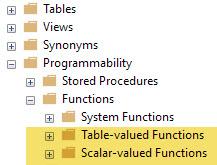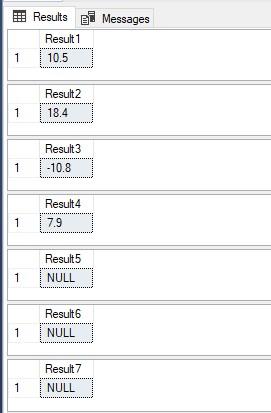After an Oracle migration, write out a function into a View SELECT statement
-
This is the function oracle.xxxfloat
BEGIN
IF @first IS NULL OR @second IS NULL
RETURN NULL
IF @first < @second
RETURN @first
RETURN @second
END
Here is the select statement getting column2, where I need to write the function 'oracle.xxxfloat' inline as part of the select
so I can phaze out the above function. In other cases it was straight forward, but not sure
how to approach this one. I'm pretty sure the @first would represent the first CASE, and @second would represent the second CASE, but not sure how to write them into the format of the function. Sorry if my question is not clear; I'm not very clear on how to write in the function. (Please ignore the other oracle function 'oracle.round' - I'm not removing that one yet).
I redacted too much info, apologies - this is correct (with column name changes/redacted)
SELECT
Column1,
oracle.xxxfloat(ISNULL(ssma_oracle.round_numeric_0(SUM(
CASE
WHEN Column8 LIKE '%E' THEN Column9
END) / NULLIF(SUM(
CASE
Column8 LIKE '%E' THEN Column10
END), 0) * 100), 0), 100) AS Column2,
-
February 25, 2025 at 2:31 pm
DECLARE @first INT = 13
,@second INT = 2;
SELECT Result = CASE
WHEN @first IS NULL
OR @second IS NULL THEN
NULL
WHEN @first < @second THEN
@first
ELSE
@second
END; -
February 25, 2025 at 3:11 pm
Sorry Phil, I had to correct my statement. When I redacted our names, I redacted too much. I guess you could say I over redacted.
-
February 25, 2025 at 3:44 pm
stevec883 wrote:Sorry Phil, I had to correct my statement. When I redacted our names, I redacted too much. I guess you could say I over redacted.
OK (and good pun!). I don't do Oracle (and the code looks weird from a SQL Server point of view), so will leave this to someone who does.
-
February 25, 2025 at 4:00 pm
Thanks LOL - couldn't resist the pun. The code does not have any remarks to clarify. I can't understand what it is doing either -- just trying to get into the function format. Also, this is after a migration from Oracle to SQL, so the code is all T-SQL, no Oracle, but yeah...it's confusing. Thanks for taking a look.
-
February 25, 2025 at 4:25 pm
Are you trying to rewrite the Oracle functions? In which case, you'll need their definitions, not just the code which is using them. If not, I don't really understand what you are trying to achieve.
-
February 25, 2025 at 5:01 pm
I'm trying to eliminate the function by rewriting the code where it is used. The listed function, Oracle.xxxfloat, I would like to remove from the column2 statement; (These functions were created by an Oracle migration tool, to convert the database to SQL). The function works just fine and produces a result set, this is just a part of one of the select statements (if I can figure this one out, it almost the exact same as the rest of the columns). My company wants all of the functions to just be written into the code (all Oracle tool created functions).
SELECT
Column1,
oracle.xxxfloat(ISNULL(ssma_oracle.round_numeric_0(SUM(
CASE
WHEN Column8 LIKE '%E' THEN Column9
END) / NULLIF(SUM(
CASE
Column8 LIKE '%E' THEN Column10
END), 0) * 100), 0), 100) AS Column2,
-
February 25, 2025 at 5:47 pm
Understood. But in your database, the function definition will exist. Otherwise the code you provide would not execute.
You need to provide that (in the form of CREATE FUNCTION oracle.xxxfloat AS …) before anyone here can begin to write out the T-SQL code for you which will do it in-line.

-
February 25, 2025 at 5:52 pm
I didn't include the full "CREATE" statement, sorry to throw you off. I just listed what it contains at the beginning of my post:
This is the function oracle.xxxfloat
BEGIN
IF @first IS NULL OR @second IS NULL
RETURN NULL
IF @first < @second
RETURN @first
RETURN @second
END
So the full statement is:
CREATE FUNCTION oracle.xxxfloat (@first AS FLOAT, @second AS FLOAT)
RETRNS FLOAT
BEGIN
IF @first IS NULL OR @second IS NULL
RETURN NULL
IF @first < @second
RETURN @first
RETURN @second
END
- This reply was modified 1 month ago by stevec883.
-
February 25, 2025 at 7:48 pm
Create a new schema:
IF NOT EXISTS (SELECT 1 FROM sys.schemas WHERE name = 'oracle')
EXEC('CREATE SCHEMA oracle;');
GOCreate the function:
GO
CREATE OR ALTER FUNCTION oracle.xxxfloat (@first FLOAT, @second FLOAT)
RETURNS FLOAT
AS
BEGIN
DECLARE @result FLOAT;
IF @first IS NULL OR @second IS NULL
RETURN NULL;
IF @first < @second
SET @result = @first;
ELSE
SET @result = @second;
RETURN @result;
END;
GOTest it:
-- Test Cases
SELECT oracle.xxxfloat(10.5, 20.3) AS Result1; -- Expected: 10.5
SELECT oracle.xxxfloat(25.7, 18.4) AS Result2; -- Expected: 18.4
SELECT oracle.xxxfloat(-5.2, -10.8) AS Result3; -- Expected: -10.8
SELECT oracle.xxxfloat(7.9, 7.9) AS Result4; -- Expected: 7.9
SELECT oracle.xxxfloat(NULL, 5.5) AS Result5; -- Expected: NULL
SELECT oracle.xxxfloat(12.3, NULL) AS Result6; -- Expected: NULL
SELECT oracle.xxxfloat(NULL, NULL) AS Result7; -- Expected: NULLResults:

- stevec883 wrote:
I'm trying to eliminate the function by rewriting the code where it is used. The listed function, Oracle.xxxfloat, I would like to remove from the column2 statement; (These functions were created by an Oracle migration tool, to convert the database to SQL). The function works just fine and produces a result set, this is just a part of one of the select statements (if I can figure this one out, it almost the exact same as the rest of the columns). My company wants all of the functions to just be written into the code (all Oracle tool created functions).
SELECT
Column1,
oracle.xxxfloat(ISNULL(ssma_oracle.round_numeric_0(SUM(
CASE
WHEN Column8 LIKE '%E' THEN Column9
END) / NULLIF(SUM(
CASE
Column8 LIKE '%E' THEN Column10
END), 0) * 100), 0), 100) AS Column2,
SELECT
Column1,
CASE
WHEN ISNULL(ROUND(
SUM(CASE WHEN Column8 LIKE '%E' THEN Column9 END)
/ NULLIF(SUM(CASE WHEN Column8 LIKE '%E' THEN Column10 END), 0) * 100, 0
), 0) < 100
THEN ISNULL(ROUND(
SUM(CASE WHEN Column8 LIKE '%E' THEN Column9 END)
/ NULLIF(SUM(CASE WHEN Column8 LIKE '%E' THEN Column10 END), 0) * 100, 0
), 0)
ELSE 100
END AS Column2 -
February 25, 2025 at 9:37 pm
Wow, thanks Jonathan. That works perfectly with a small exception that I have decimals in column 2. But the result set for column2 is correct, except for the 0's, exactly 6 zeros to the right of the decimal for each correct number. Perhaps I need a slight adjustment in the math(?). 0 has a result of 0.000000, 96 has a result of 96.000000, etc. It could even be a mistake on my end transfering your arrangement. Wow, you're good!
In any case, I'm on the right path, so thanks a ton!
-
February 28, 2025 at 5:29 pm
This was removed by the editor as SPAM
-
March 3, 2025 at 9:44 pm
This was removed by the editor as SPAM
-
March 12, 2025 at 7:53 am
Once you have a function that works, include the WITH SCHEMABINDING clause in the function definition. It will run much faster.
Original author: https://github.com/SQL-FineBuild/Common/wiki/ 1-click install and best practice configuration of SQL Server 2019, 2017 2016, 2014, 2012, 2008 R2, 2008 and 2005.
When I give food to the poor they call me a saint. When I ask why they are poor they call me a communist - Archbishop Hélder Câmara
Viewing 15 posts - 1 through 15 (of 15 total)
You must be logged in to reply to this topic. Login to reply

